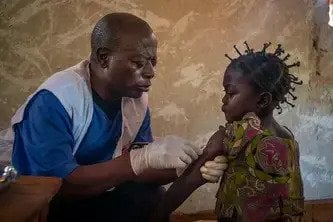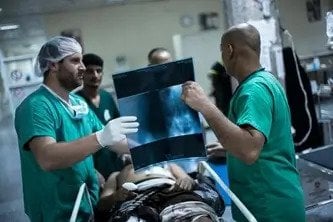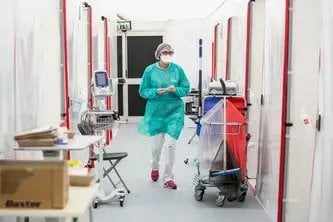Video 1: Vukovar convoy
13 November 1991
INA/France 3 – Florence Villagi, MSF. (Video in French)
Video 2: 1992, MSF - A Year in focus
War in Yugoslavia. The MSF team was the first to enter besieged Vukovar. Its task is to evacuate 300 injured victims.
MSF. (Video in French)
Video 3: MSF France President's call to an armed intervention
Rony Brauman, President of MSF France, speaks about the situation in Sarajevo and criticizes the Western response to the conflict.
29 May 1992
RTL. (Audio in French)
Video 4: Kozarac report
Rony Brauman, president of MSF France, presents the MSF report (the Kozarac report) on ethnic cleansing in Bosnia-Herzegovina.
INA/France 3. (Video in French)
Video 5: Ethnic cleansing
Interview with Jean Porrini (Secretary General of MDM) and Rony Brauman (President of MSF France) on ethnic cleansing in Bosnia.
29 December 1992
INA/France 2 – Rony Brauman, MSF. (Video in French)
Video 6: General Morillon in Srebrenica
13 March 1993
INA/France 2. (Video in French)
Video 7: Rony Brauman on Srebrenica
17 April 1993
In this interview, Rony Brauman, President of MSF France, criticizes Western governments and European citizens for failing to prevent a stIn this interview, Rony Brauman, President of MSF France, criticizes Western governments and European citizens for failing to prevent a strategy of racial domination and territorial conquest in Europe. This inaction is described as leading to a barbaric situation.
INA/France 2 – Rony Brauman, MSF. (Video in French)
Video 8: A year in focus, 1993
Bosnia: discovery of the detention camps. 87 detainees resettled from these camps will arrive in France with their families. An MSF team is assessing their medical and psychological needs.
A Year in Focus, MSF France
Video 9: Rony Brauman on Sarajevo
7 February 1994
Interview with Rony Brauman, President of MSF France, by Jean Luc Hees. He expresses his indignation and pessimism about the resources being deployed to help the besieged populations.
INA/France Inter – Rony Brauman, MSF. (Audio in French)
Video 10: Eric Stobbaerts: Gorazde
10 April 1994
Telephone interview with Eric Stobbaert, from MSF in Belgrade, for an on the situation in Gorazde, a Muslim enclave in Bosnia, under fire from the Serb offensive.
INA/France 3 – Eric Stobbaerts, MSF. (Video in French)
Video 11: Rony Brauman: Gorazde
11 April 1994
Interview with Rony Brauman, President of MSF France, by Annette Ardisson. He talks about the consequences of the UN air strikes in Gorazde, and in particular on the humanitarian teams in place.
INA/France Inter – Rony Brauman, MSF. (Audio in French)
Video 12: Situation in Gorazde
18 April 1994
MSF is one of the humanitarian organisations still present in Gorazde, along with the Red Cross and the UNHCR. Rony Brauman, president of MSF, accuses the UN of misinforming international opinion about the catastrophic situation in the Muslim enclave.
INA/France 2. (Video in French)
Video 13: Call for Yasushi Akashi's resignation
18 April 1994
Situation in former Yugoslavia: The Muslim enclave of Gorazde, officially declared a ‘protected area’ by the United Nations, has fallen into the hands of Serb forces after a three-week offensive, despite NATO air strikes and UN threats. Interview with Rony Brauman, President of MSF France, denouncing the false statements made by Yasushi Akashi.
INA/France 3 – Rony Brauman, MSF. (Video in French)
Video 14: Lt Gen Michael Rose's Press Conference on Gorazde
18 April 1994
Michael Rose, commander of U.N. forces in Bosnia, declared that Bosnian Serbs could enter the town if they wanted to. "We now find ourselves in a very serious situation indeed in and around Gorazde," Rose told reporters at a daily briefing in Sarajevo.
Associated Press. (Video in English)
Video 15: Rony Brauman on his interview with François Mitterand – French
21 April 1994
Interview with Rony Brauman, President of MSF France, who was received by the French President, François Mitterrand: ‘We have the impression that every day we are reaching a peak in horror in Gorazde...’.
INA/France 3. (Video in French)
Video 16: A year in focus, 1994
1994
The Gorazde enclave, declared previously a secured zone, is since mid-April caught in a barrage of fire. Two MSF staff witness the demise of the enclave.
MSF France (Video in French)
Video 17: Stephan Oberreit: Srebrenica
12 July 1995
On Tuesday 11 July, Bosnian Serb forces overran the Muslim enclave of Srebrenica in eastern Bosnia. 30,000 people have fled and are trying to find refuge around Potocari, the main UNPROFOR base in the region. This enclave became a UN security zone in 1993. By telephone, Stéphan Oberreit, MSF coordinator in Belgrade, reports on the situation.
INA/France 2 – Stephan Oberreit, MSF (Video in French)
Video 18: Fall of Srebrenica
12 July 1995
Interview of Stephane Oberreit, MSF Coordinator in Belgrade. He describes the scenes of separation and exile in Srebrenica and the dramatic health situation in the enclave: “it is urgent for humanitarian organisations to have access to Srebrenica.”
INA/France Inter (radio) – Prise de Srebrenica - Stephan Oberreit, MSF (Audio in French)
Video 19: Srebrenica: Ethnic Cleansing
11-13 July 1995
Ethnic cleansing’ is once again under way in Bosnia, in the Muslim enclave of Srebrenica, which Serb forces seized on Tuesday 11 July. The Serbs have begun to organise the expulsion of the enclave's Muslim population, under the direction of their commander, General Mladic. Thousands of refugees ended up in Tuzla, another Muslim enclave, to escape the Serbs.
INA/France 2 – Srebrenica: Epuration ethnique (Video in French)
Video 20: Christina Schmitz on Srebrenica
2014
Interview of Christina Schmitz, MSF field coordinator in Srebrenica in 1995.
Extract of ‘MSF(UN)Limited’, an MSF Documentary film. (Video in English)
Video 21: Srebrenica in Memoriam
12 August 1995
In May 1993, the UN declared Srebrenica a safe area. Two years later, following an assault by Serb forces, the enclave fell, despite the presence of a contingent of Dutch peacekeepers. Through the testimonies of a Dutch peacekeeper and Bosnian refugees, this film traces the end of the enclave.
A documentary by Christophe Picart/EUP/MSF. (Video in English)
Video 22: Envoyé spécial
12-13 October 1995
Pierre Salignon, MSF Deputy Programme Manager in the former Yugoslavia: - ‘I work with refugees at the hospital in Srebrenica. The stories are so serious that we decided to make them public... Between five and eight thousand people have disappeared, mostly men who fled into the forest. In Srebrenica, the fall was the culmination of ethnic cleansing and deportations to Tuzla’.
INA/France 2 – Pierre Salignon, MSF. (Video in French)
Video 23: Les 4 vérités : Pierre Salignon
14 August 1995
On the news set, Pierre Salignon, MSF Deputy Programme Manager in the former Yugoslavia.
INA/France 2 – Les quatre vérités – Pierre Salignon, MSF (Video in French)
Video 24: Dayton peace agreement
16 December 1995
(Min 2:35) Extract from an interview with Rony Brauman, former President of MSF. In his opinion, the failure to resolve the issue of refugees who see no prospect of returning to their country in the near future.
INA/France Inter – Accords de Dayton - Rony Brauman, MSF (Audio in French)
Video 25: French Parliamentary Fact-Finding Commission on Srebrenica
29 March 2001
Hearing of Christina Schmitz and Daniel O’Brien, MSF members, by French Parliamentary Fact-Finding Commission on Srebrenica.
MSF
Video 26: A Year in Focus, 2001
22 June 2001
Srebrenica Fall: With the Parliamentary Fact-Finding Commission on Srebrenica, members of Parliament are investigating in the military aspect of the fall of the enclave of Srebrenica.
MSF France (French)
Video 27: Parliamentary Fact-Finding Commission on Srebrenica
29 November 2001
News report dedicated to the report of the parliamentary mission on the Srebrenica massacre, designed to assess France's responsibility in the operation. Interview with Jean-Hervé Bradol from MSF.
INA/France 3 – Jean-Hervé Bradol, MSF (Video in French)
Video 28: Serb Parliament Public Apology for the Massacre of Srebrenica
31 March 2010
After 13 hours of debate, the Serbian parliament has adopted a resolution publicly apologising for the massacre of 8,000 Bosnian Muslims in Srebrenica in 1995. Deep divisions remain in the country over this chapter of history, and the Serbian far right demonstrated outside parliament.
INA/France 3 (Video in French)


